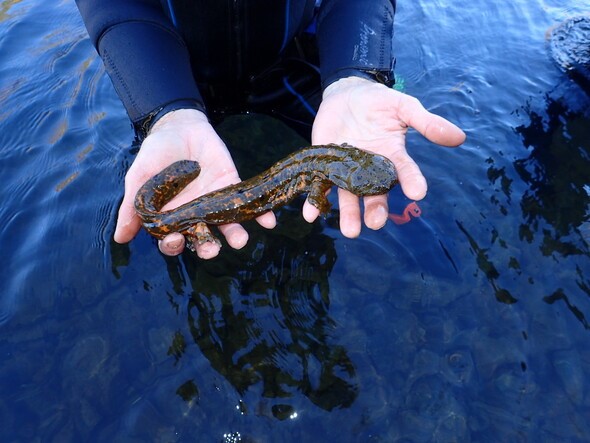The hellbender is a type of salamander native to eastern North America, particularly in regions with clean, cold, fast-flowing streams and rivers. Here are some key facts about the hellbender:
- Appearance: Hellbenders are large, aquatic salamanders known for their flat bodies and wrinkled appearance. They have a slimy, loose-fitting, and wrinkled skin that helps them breathe through their skin. They are typically brown or grayish-brown with dark blotches.
- Size: Hellbenders are among the largest salamanders in the world. They can grow up to 29 inches (74 cm) in length, although most individuals are smaller.
- Habitat: They are primarily aquatic and prefer clear, fast-flowing streams with rocky substrates. These streams provide an ideal habitat for hellbenders because of the high oxygen content in the water.
- Diet: Hellbenders are carnivorous and primarily feed on aquatic invertebrates like crayfish, insects, and small fish. They use their keen sense of smell to locate prey.
- Reproduction: Hellbenders have an interesting method of reproduction. The female lays eggs in a nest that the male guards. After hatching, the male continues to guard the eggs and protect the young larvae.
- Conservation Status: Hellbenders are considered a near-threatened species due to habitat loss, pollution, and disease. Conservation efforts are in place to protect their natural habitats and populations.
- Ecological Role: They play a vital role in maintaining the health of aquatic ecosystems by controlling populations of certain prey species and serving as indicators of water quality.
- Nicknames: Hellbenders are often called “snot otters” or “mud puppies” due to their slimy appearance and unusual names.
- Scientific Name: The hellbender’s scientific name is Cryptobranchus alleganiensis. There are two recognized subspecies: the Eastern hellbender (Cryptobranchus alleganiensis alleganiensis) and the Ozark hellbender (Cryptobranchus alleganiensis bishopi).
- Cultural Importance: Hellbenders have cultural significance in some indigenous cultures in North America and are considered an important part of the local ecosystems.
Due to their unique appearance and ecological role, hellbenders are fascinating creatures that are of interest to biologists and conservationists. Efforts to protect their habitats and study their populations are ongoing to ensure their survival in the wild.
